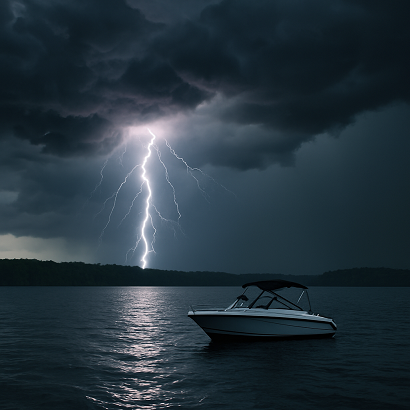Nestled in the rolling hills of northeastern Pennsylvania, Lake Wallenpaupack and the surrounding Pocono Mountains are a haven not just for vacationers and anglers—but for birds. From powerful birds of prey to elusive songbirds and stately waders, this region teems with avian life year-round.
Whether you’re a seasoned birder or a curious hiker with a pair of binoculars, there’s a rich diversity of feathered residents and visitors to discover. This guide explores the many species you may encounter around the lake and throughout the woodlands, wetlands, and skies of the Poconos.
1. The Sky Sovereigns: Birds of Prey
Bald Eagle (Haliaeetus leucocephalus)
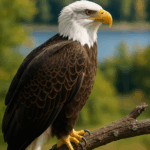
Once nearly extinct in the Lower 48, the bald eagle is now a comeback story and a common sight around Lake Wallenpaupack. With their iconic white heads, massive wingspa
ns (up to 7 feet!), and piercing yellow eyes, these eagles often soar over the lake or perch high in tall conifers.
🪶 Best time to spot: Year-round, but particularly active in winter and spring
📍 Where to look: Lake shorelines, tall trees near coves, or floating ice in colder months
Osprey (Pandion haliaetus)
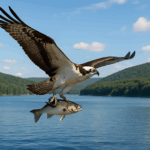
Often confused with bald eagles, ospreys are slightly smaller and specialize in fishing. You’ll recognize them by their white bellies and dark eye-stripes. Watch for dramatic dives into the water as they snatch trout or perch from the lake with astonishing precision.
🪶 Best time to spot: Spring through early fall
📍 Where to look: Nesting platforms near the lake, rocky outcrops, or diving near the dam
Red-tailed Hawk (Buteo jamaicensis)
These broad-winged hawks are common throughout the Poconos. With their signature reddish-brown tails and loud, raspy cries, red-tailed hawks are often seen circling above open fields or perched along rural roads.
🪶 Best time to spot: Year-round
📍 Where to look: Roadside telephone poles, tree lines near open fields, soaring thermals
2. Elegant Waders: Herons and Egrets
Great Blue Heron (Ardea herodias)
A solitary fisher with slow, graceful movements, the great blue heron is a tall, slate-gray bird with a dagger-like beak. When startled, they fly with slow, deep wingbeats, legs trailing behind like a kite tail.
🪶 Best time to spot: Spring through fall
📍 Where to look: Marshy edges of the lake, small inlets, and shallow wetlands
Great Egret (Ardea alba)
Rare but increasingly visible in the area, the great egret is a vision of pure white elegance. Slightly smaller than the heron, it shares a similar hunting style—still and patient, ready to spear fish or amphibians.
🪶 Best time to spot: Late spring to early fall
📍 Where to look: Quiet coves, lily-pad beds, and along river outlets
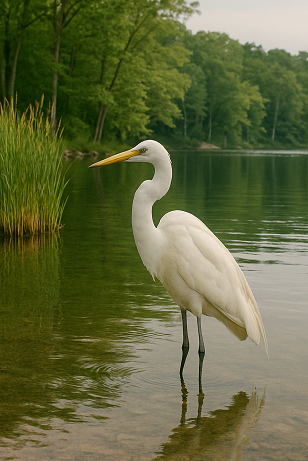
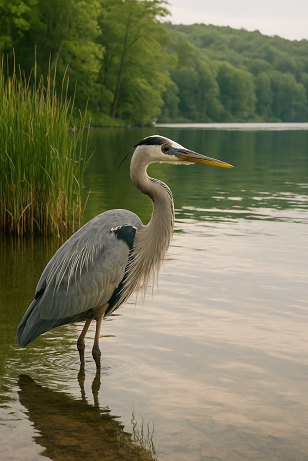
3. Forest Drummers: Woodpeckers of the Poconos
Pileated Woodpecker (Dryocopus pileatus)
This is the showstopper of the woods—nearly crow-sized with a flaming red crest and bold black-and-white coloring. Its echoing “drum” can be heard deep in mature hardwood forests. Think of it as the inspiration for Woody Woodpecker.
Best time to spot: Year-round
Where to look: Old-growth woods, dead trees, or logs with visible holes
Red-bellied Woodpecker (Melanerpes carolinus)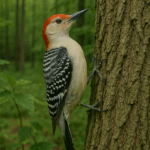
Despite its name, this bird sports more red on its head than its belly. It’s a frequent visitor to backyard feeders and makes a distinctive rolling call that sounds like a chuckle.
Best time to spot: Year-round
Where to look: Forest edges, wooded residential areas, bird feeders
Downy & Hairy Woodpeckers (Picoides pubescens & Picoides villosus)
These two are hard to tell apart—both are black and white with a touch of red on the head. Downy is smaller, with a shorter beak. They love suet feeders and are agile climbers.
Best time to spot: Year-round
Where to look: Tree trunks, backyard feeders, wooded trails
4. Hidden Gems: Songbirds, Warblers & Others
Scarlet Tanager (Piranga olivacea)
A splash of tropical color in the forest canopy, the male scarlet tanager is blazing red with black wings. These birds are elusive and often easier to hear than to see.
🪶 Best time to spot: Late spring through summer
📍 Where to look: Deciduous forests, high in the canopy
Black-throated Blue Warbler (Setophaga caerulescens)
This striking little bird—midnight blue with a bold black throat—passes through the Poconos in migration and may nest in higher elevations.
🪶 Best time to spot: Spring and fall migration
📍 Where to look: Dense understory in mixed hardwood forests
Eastern Bluebird (Sialia sialis)
The symbol of hope and happiness, the eastern bluebird is a beloved sight on fenceposts and meadows. Males boast bright blue backs and warm orange chests.
🪶 Best time to spot: Spring through fall (some overwinter)
📍 Where to look: Open fields, nest boxes, and orchards
Cedar Waxwing (Bombycilla cedrorum)
Elegant and soft-looking, these birds have silky plumage, a black mask, and red waxy tips on their wings. They travel in flocks and feast on berries.
🪶 Best time to spot: Summer and early fall
📍 Where to look: Berry bushes, forest edges, lakeside trees
5. Water & Shore Birds
Common Loon (Gavia immer)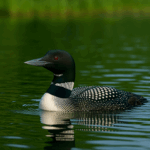
With eerie, flute-like calls and dramatic black-and-white breeding plumage, loons are occasional migrants through the lake. While they rarely nest here, their haunting calls are unforgettable.
🪶 Best time to spot: Spring and fall
📍 Where to look: Deeper parts of the lake, especially early in the morning
Double-crested Cormorant (Phalacrocorax auritus)
These dark, prehistoric-looking birds are expert divers. Often seen perched on rocks or logs, wings spread wide to dry.
🪶 Best time to spot: Spring through fall
📍 Where to look: Open lake water, roosting spots near small islands
6. Winter Guests & Seasonal Surprises
Dark-eyed Junco (Junco hyemalis)
Nicknamed “snowbirds,” these slate-gray birds with white bellies arrive in flocks each winter, flitting around snowy roadsides and feeders.
🪶 Best time to spot: Late fall through early spring
📍 Where to look: Forest edges, feeders, trails with snow cover
Snowy Owl (Bubo scandiacus)
While not common, the snowy owl occasionally ventures into Pennsylvania during irruption years. Spotting one perched on a fencepost or field stump is a rare and magical winter gift.
🪶 Best time to spot: Irregular winters (watch local bird reports)
📍 Where to look: Wide open fields, airport areas, snow-covered ridges
Tips for Birdwatching in the Region
-
- Best Times of Day: Early morning (sunrise to 10 a.m.) is prime birding time.
- Bring Binoculars: A pair with 8x42 magnification is a great all-around choice.
- Listen First: Many birds are heard before they’re seen—apps like Merlin or Audubon can help identify calls.
- Use AI for ID: AI tools and camera apps like Merlin Bird ID or Seek by iNaturalist make identification easier.
- Respect Nesting Areas: Stay back from nests or fledglings to avoid disturbing natural behavior.
Final Thoughts
Lake Wallenpaupack and the Poconos aren't just a retreat for people—they're a vibrant, ever-changing theater for birdlife. From aerial acrobatics to melodic songs, these creatures enrich the region with color, sound, and motion.
So next time you're walking the lakeshore, hiking a trail, or sipping coffee on the porch, look—and listen—closely. The skies and trees are alive with winged wonders.
